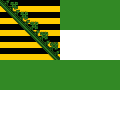Top Qs
Timeline
Chat
Perspective
Flag of Saxony
From Wikipedia, the free encyclopedia
Remove ads
Both the civil and state flag of the German state of Saxony feature a bicolour of white over green, similar to the Austrian province of Styria although they are historically not related to each other. The state flag is similar to the civil flag, except it is defaced in the centre with the coat of arms of Saxony. The colours of both flags were officially decided as state colours in 1815[1] in the Kingdom of Saxony. The aristocracy used mostly and in first time the quadrangular version and later the rectangular.
You can help expand this article with text translated from the corresponding article in German. (November 2022) Click [show] for important translation instructions.
|
Remove ads
Design
The civil bicolour flag of white over green was used before World War II, and formally abolished in 1935, under the reforms of the Third Reich. It was readopted 1945 when Saxony became a state again, and abolished 1952 under governing reforms of the German Democratic Republic. When Germany was reunited, Saxony became a state again, and so the flag was finally officially readopted in 1991, having been a much used symbol during the demonstrations in the German Democratic Republic in 1989/90.[2]
Colors
The Constitution of the Free State of Saxony defines the "state colors" as simply "white and green", with no further specifications.[3] On 2 June 1999, the federal cabinet introduced a corporate design for the German government which defined "green" as RGB 0,133,74 or PANTONE® 7731, but it is unclear if these guidelines apply to the states, and in any case, in practice the specific shades can vary wildly, especially in unofficial uses.[4][5]
- For newspapers.
Remove ads
Landtag of the Free State of Saxony
Landtag of the Free State of Saxony uses its own flag.
 Flag of Landtag of Saxony.
Flag of Landtag of Saxony.
Minority flags
Paragraph 4 of Article 2 of the Constitution of the Free State of Saxony guarantees other flags equality alongside the Saxon state flag.[6]
 Flag of Silesians (with eagle)
Flag of Silesians (with eagle)
Gallery
Previous versions
 Saxon flag by the House of Ascania; associated for the Saxon Ostmark and battleflag for the Saxon Eastern March; crusades around 950
Saxon flag by the House of Ascania; associated for the Saxon Ostmark and battleflag for the Saxon Eastern March; crusades around 950 Royal standard of the House of Wettin
Royal standard of the House of Wettin Royal Standard of Prince Albert of Saxe-Coburg and Gotha as consort of Queen Victoria (1840–1861)
Royal Standard of Prince Albert of Saxe-Coburg and Gotha as consort of Queen Victoria (1840–1861) Saxe-Altenburg (1602–1672, 1826–1918, 1918–1920)
Saxe-Altenburg (1602–1672, 1826–1918, 1918–1920) Saxe-Meiningen flag design during 1826–1918
Saxe-Meiningen flag design during 1826–1918 Electorate of Saxony (1356–1806)
Electorate of Saxony (1356–1806) The height of Saxony's power: Royal standard of the Saxon Kings of Poland-Lithuania (1697–1706; 1709–1763)
The height of Saxony's power: Royal standard of the Saxon Kings of Poland-Lithuania (1697–1706; 1709–1763) Without coat of arms (the flag of the Kingdom of Saxony, until 1815)
Without coat of arms (the flag of the Kingdom of Saxony, until 1815) The flag of the Kingdom of Saxony (1815–1918), the Free State of Saxony (Weimar Republic (1918–1925), and reunified Germany (since 1991)
The flag of the Kingdom of Saxony (1815–1918), the Free State of Saxony (Weimar Republic (1918–1925), and reunified Germany (since 1991) War flag with cannons, bombs, lances and one Fire Salamander, who can live in, eat and his drunken blood protects from fire (1697–1706; 1709–1763)
War flag with cannons, bombs, lances and one Fire Salamander, who can live in, eat and his drunken blood protects from fire (1697–1706; 1709–1763) The banner of the Margraviate of Meissen for troops or princes (1806–1918)
The banner of the Margraviate of Meissen for troops or princes (1806–1918) Duchy of Saxe-Weimar-Eisenach (1809–1920)
Duchy of Saxe-Weimar-Eisenach (1809–1920) Duchy of Saxe-Eisenach (1596–1638; 1640–1644; 1662–1809)
Duchy of Saxe-Eisenach (1596–1638; 1640–1644; 1662–1809) Saxe-Coburg and Gotha (1826–1911)
Saxe-Coburg and Gotha (1826–1911) Saxe-Coburg and Gotha (1911–1920)
Saxe-Coburg and Gotha (1911–1920) Saxe-Gotha-Altenburg (1680–1826)
Saxe-Gotha-Altenburg (1680–1826) Saxe-Hildburghausen (1680–1826)
Saxe-Hildburghausen (1680–1826) Flag of Gau Saxony (1933–1945)
Flag of Gau Saxony (1933–1945)
Remove ads
See also
References
Wikiwand - on
Seamless Wikipedia browsing. On steroids.
Remove ads


























